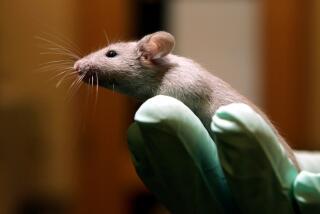Researchers discover new class of stem cells
- Share via
Researchers have identified a new class of lab-engineered stem cells -- cells capable of transforming into nearly all forms of tissue -- and have dubbed them F-class cells because they cluster together in “fuzzy-looking” colonies.
The discovery, which was described in a series of five papers published Wednesday in the journals Nature and Nature Communications, sheds new light on the process of cell reprogramming and may point the way to more efficient methods of creating stem cells, researchers say.
Due to their extraordinary shape-shifting abilities, so-called pluripotent cells have enormous value to medical researchers. They allow scientists to study the effects of drugs and disease on human cells when experiments on actual people would be impossible, and they have given rise to the field of regenerative medicine, which seeks to restore lost or damaged organs and tissues.
The F-class cells were created using genetically engineered mouse cells, and may not occur naturally outside the lab, according to senior author Andras Nagy, a stem cell researcher at Toronto’s Lunenfeld-Tanenbaum Research Institute of Mount Sinai Hospital.
However, the find suggests that there may be other classes of pluripotent cells -- or a spectrum of reprogrammed cells -- yet to be discovered, authors say.
“We think that if we have time, and money and hands to do it, we might find additional novel cell lines,” Nagy said.
Until now, stem cells have been either obtained from embryos or produced in the lab through a painstaking process called induced pluripotency, whereby a virus is used to alter an adult cell’s genetic information and return the cell to a pliable, embryonic state.
That process, which was pioneered by Dr. Shinya Yamanaka and recognized with the Nobel Prize in Physiology or Medicine in 2012, is extremely inefficient, yielding embryonic-stem-cell-like cells just 1% of the time.
Nagy and his colleagues, a consortium of international researchers called Project Grandiose, began their research by looking more closely at the castoffs of that process, or those cells that did not closely match the description of embryonic stem cells.
“We looked at it in an unbiased way,” Nagy said. “Instead of ignoring or discarding those cells that don’t look like embryonic stem cells, we thought we might find more than just one alternative cell type.”
Their hunch paid off when they identified half a dozen cells that were very similar to each other, yet very different from the gold-standard embryonic-like cells.
These F-cells were engineered in a slightly different way than most induced pluripotent stem cells. They were designed so that the cell reprogramming process would only occur when they were exposed to the antibiotic doxycycline. Once the cells were no longer exposed to the medication, they either turned into an adult specialized cells or they died, Nagy said.
The newly discovered cells could reproduce quickly and were not “sticky,” Nagy said.
“The adhesion is not that high, so they are amenable to bioreactor type of growth,” Nagy said. “We can put these cells into a big jar of media and grow them up in a suspension, which is much more efficient, cheaper, and less work to produce a huge number of cells.”
It remains to be seen whether human cells can be converted into F-class cells, but researchers say it seems highly possible.
“I think it’s inevitable that human F-class cells can be achieved in the near future through reprogramming,” said Juan Carlos Izpisua Belmonte, a developmental biologist at the Salk Institute for Biological Studies in La Jolla.
However, Belmonte, who was not involved in the research but who co-wrote an accompanying News & Views piece, said that using human F-class cells for clinical applications might prove “problematic.”
The reason for this is that their constant need to express reprogramming factors may lead to tumor formation.
“So the next important step is to find culture condition(s) that can stabilize F-Class state without transgene expression,” Belmonte wrote in an e-mail.
Paul Knoepfler, a stem cell researcher at UC Davis, who was also not involved in the study, said he guessed that F-class human cells could be made, but probably less efficiently.
“I’m most excited about the concept that there can be different kinds of reprogrammed states and pluripotent states,” Knoepfler wrote in an email.
“With the arrival of F-class cells on the scene … [who’s] to say that there aren’t additional types of pluripotent cells with unique properties that might be harnessed clinically?”
Follow @montemorin for science news






